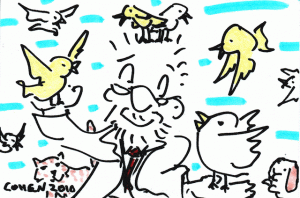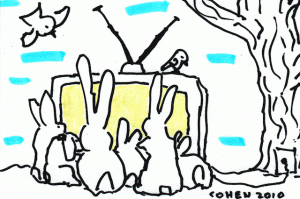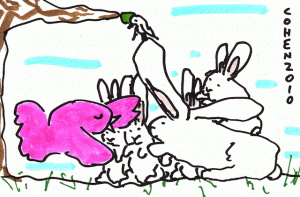 Gather and Talk
Gather and Talk
Recently (Dec. 2nd) I had the opportunity to participate in a terrific event all about the humanizing of brands called BrandsConf. Jeff Pulver brought a couple of hundred people together to gather and talk about this topic that has been brewing for a long time, but has just recently come to a boil. That got me thinking: Why now? What has accelerated these ideas that have been developing around brands for several years?
I think a big part of the “why now?” is this very human idea of gathering and talking and how technology keeps making it easier for us to do just that – easier, faster, and at a larger scale. We used to gather and talk around the campfire, the dinner table, the watercooler, and now we’ve added al kinds of new places to gather and talk: chat rooms, comment threads, profile pages, Facebook walls and Twitter streams. We’ll virtually convene and debate over fanboy flamewars, activist causes, and even which thermos is really worth 24.99.
Not Gathered, but Talking
There used to be a little more clarity about when you were having a tête-à-tête, versus making a speech, or gathering a consensus. Now a conversation might be all of those things at once: one to one, one to many, and many to one all at once – and throw in many to many just for good measure. You also used to know when a conversation started and ended, but when the gathering is virtual it can also be asynchronous, or semi-synchronous, dialog and document all at once.
This isn’t just semantics (although I really like semantics), a lot of the reflexes we have formed based on the way we gather and talk in the physical world are being stress-tested by these new modes. Capacity, memory, history, context used to be things we could reliably judge in a more visceral way. There is a kinship in the gut between our skills as pattern recognizers and our effectiveness as B.S. detectors.
 Gathered, but Not Talking
Gathered, but Not Talking
But I don’t think our reflexes are quite a sharp as they used to be, not as a whole. You see we spent a lot of years gathering, but not talking, first due to the radio, and later the TV. Add cable and cheaper electronics and we even began to lose the gathering – we were separating and not talking. IMHO our dialog skills got a little bit atrophied, especially when it comes to brands. We got comfortable with brands being spoon fed to us like cereal and Saturday morning cartoons. Our brand conversations were at best about brands, not with brands.
Search Me
Sorry about hopping around, but that’s just how my mind works sometimes. I’m not as random as Clifford Stoll yet, but give me time… So what was I saying? Search me…
Well that’s how we used to use that phrase: “Search me” was a handy expression to say I don’t know, or I don’t have the answer. Now “search me” is a directive, a request, a precipitate of this idea that we have a personal brand. Search me means that I have an answer and I want you to check me out so you know what you’re getting. This is where I think we as individuals can learn much from what the big brands have refined over the years, ideas like focus, consistency, aspiration and segmentation. And why is this important? Many of us come to a world with muscle-memory that was built when conversations were things that happened with a tiny scope, that faded away quickly, if not instantaneously, and we’re bringing those reflexes to a world where nothing is erased, everything is searchable, and the only way to hide a blemish is to crowd it out – make it harder to find by drowning it in a sea of positives.
I think this is why authenticity is so important to building a personal brand – every day we are offered the opportunity and consequence of operating like one-person media empires. Yet without the resources of a major brand or a billionaire media-magnate behind us it is essential that we steer our ships carefully, thoughtfully and with purpose. Our authenticity is our compass. It’s how we find our way, how we get back on track when we get buffeted around by life’s hard knocks and gleaming opportunities. It’s also the one resource that we know we won’t tap out while we’re hustling to keep up with the big shots and the big brands with their deep benches and deep pockets.
The good news is, it’s a lot easier to get big virtually than physically. The micro-brand can go global. The personal brand that embraces clarity and focus, that can bring an authentic remarkableness to market, can indeed go global. Your flavor of weird, if it’s real, might just be your win.
Talk to Me
So certainly there are heaps of brand wisdom that the little upstart can learn from big dogs like Nike, Apple, McDonald’s, Coke, Harley Davidson, etc. But can the scrappy, squishy, touchy-feely, human being at the center of a personal brand offer anything for the big brands to learn. Can you teach a big dog new tricks?
Well I think just as we as individuals have some communication reflexes that aren’t quite caught up with the new modes of semi-synchronous, always searchable, un-erasable, gathering and talking, so too are the big brands faced with outdated approaches and behavioral biases built on assumptions from other modes of communication. The command and control, TV, print, radio, megaplex paradigm depends on cascading layers of one-way filters that allowed information to flow down and out, but prevented the vast majority of the upstream communication from getting back to the top. All of that today can be subverted with a single tweet. It’s not a wolf at the door, but a human, just a few keystrokes away, and she wants to talk – not be lectured, or given the latest spin.
The social innovations of today’s Internet have brought back the talk to the gather and talk and large companies will be wise to recognize that we are not just demographics, not just a count of households in a statistical strata, but humans at every turn and in every nook and cranny – we’re squishy and we want to talk.
 Hear Me
Hear Me
With all this talking and gathering another very human need is revealed – the need to be heard. The personal brand bold enough to build a narrative on a foundation of authenticity wants desperately to be accepted and acknowledge for that very thing. The person who tweets a complaint about a bad bit of customer service, or a disappointing product experience also wants to be acknowledged, engaged and will react to the brand that does so in much the same way as they would react to a human acknowledgement.
So, Now…
The social technology has positioned us as individuals to realize the potential and responsibility of being a great brand, while also reminding big brands that they are surrounded by and suffused with humans. Their potential and responsibility will be revealed in how they choose to engage in a world of trackable, semi-synchronous, and squishy human-to-human communication.
That’s why now.
If you want to get a little more of the flavor of BrandsConf search for the hashtag #brandsconf on Twitter and check out my doodle-notes made during the event.










Explore the Humanizing of Brands – Why Now?
Recently (Dec. 2nd) I had the opportunity to participate in a terrific event all about the humanizing of brands called BrandsConf. Jeff Pulver brought a couple of hundred people together to gather and talk about this topic that has been brewing for a long time, but has just recently come to a boil. That got me thinking: Why now? What has accelerated these ideas that have been developing around brands for several years?
I think a big part of the “why now?” is this very human idea of gathering and talking and how technology keeps making it easier for us to do just that – easier, faster, and at a larger scale. We used to gather and talk around the campfire, the dinner table, the watercooler, and now we’ve added al kinds of new places to gather and talk: chat rooms, comment threads, profile pages, Facebook walls and Twitter streams. We’ll virtually convene and debate over fanboy flamewars, activist causes, and even which thermos is really worth 24.99.
Not Gathered, but Talking
There used to be a little more clarity about when you were having a tête-à-tête, versus making a speech, or gathering a consensus. Now a conversation might be all of those things at once: one to one, one to many, and many to one all at once – and throw in many to many just for good measure. You also used to know when a conversation started and ended, but when the gathering is virtual it can also be asynchronous, or semi-synchronous, dialog and document all at once.
This isn’t just semantics (although I really like semantics), a lot of the reflexes we have formed based on the way we gather and talk in the physical world are being stress-tested by these new modes. Capacity, memory, history, context used to be things we could reliably judge in a more visceral way. There is a kinship in the gut between our skills as pattern recognizers and our effectiveness as B.S. detectors.
But I don’t think our reflexes are quite a sharp as they used to be, not as a whole. You see we spent a lot of years gathering, but not talking, first due to the radio, and later the TV. Add cable and cheaper electronics and we even began to lose the gathering – we were separating and not talking. IMHO our dialog skills got a little bit atrophied, especially when it comes to brands. We got comfortable with brands being spoon fed to us like cereal and Saturday morning cartoons. Our brand conversations were at best about brands, not with brands.
Search Me
Sorry about hopping around, but that’s just how my mind works sometimes. I’m not as random as Clifford Stoll yet, but give me time… So what was I saying? Search me…
Well that’s how we used to use that phrase: “Search me” was a handy expression to say I don’t know, or I don’t have the answer. Now “search me” is a directive, a request, a precipitate of this idea that we have a personal brand. Search me means that I have an answer and I want you to check me out so you know what you’re getting. This is where I think we as individuals can learn much from what the big brands have refined over the years, ideas like focus, consistency, aspiration and segmentation. And why is this important? Many of us come to a world with muscle-memory that was built when conversations were things that happened with a tiny scope, that faded away quickly, if not instantaneously, and we’re bringing those reflexes to a world where nothing is erased, everything is searchable, and the only way to hide a blemish is to crowd it out – make it harder to find by drowning it in a sea of positives.
I think this is why authenticity is so important to building a personal brand – every day we are offered the opportunity and consequence of operating like one-person media empires. Yet without the resources of a major brand or a billionaire media-magnate behind us it is essential that we steer our ships carefully, thoughtfully and with purpose. Our authenticity is our compass. It’s how we find our way, how we get back on track when we get buffeted around by life’s hard knocks and gleaming opportunities. It’s also the one resource that we know we won’t tap out while we’re hustling to keep up with the big shots and the big brands with their deep benches and deep pockets.
The good news is, it’s a lot easier to get big virtually than physically. The micro-brand can go global. The personal brand that embraces clarity and focus, that can bring an authentic remarkableness to market, can indeed go global. Your flavor of weird, if it’s real, might just be your win.
Talk to Me
So certainly there are heaps of brand wisdom that the little upstart can learn from big dogs like Nike, Apple, McDonald’s, Coke, Harley Davidson, etc. But can the scrappy, squishy, touchy-feely, human being at the center of a personal brand offer anything for the big brands to learn. Can you teach a big dog new tricks?
Well I think just as we as individuals have some communication reflexes that aren’t quite caught up with the new modes of semi-synchronous, always searchable, un-erasable, gathering and talking, so too are the big brands faced with outdated approaches and behavioral biases built on assumptions from other modes of communication. The command and control, TV, print, radio, megaplex paradigm depends on cascading layers of one-way filters that allowed information to flow down and out, but prevented the vast majority of the upstream communication from getting back to the top. All of that today can be subverted with a single tweet. It’s not a wolf at the door, but a human, just a few keystrokes away, and she wants to talk – not be lectured, or given the latest spin.
The social innovations of today’s Internet have brought back the talk to the gather and talk and large companies will be wise to recognize that we are not just demographics, not just a count of households in a statistical strata, but humans at every turn and in every nook and cranny – we’re squishy and we want to talk.
With all this talking and gathering another very human need is revealed – the need to be heard. The personal brand bold enough to build a narrative on a foundation of authenticity wants desperately to be accepted and acknowledge for that very thing. The person who tweets a complaint about a bad bit of customer service, or a disappointing product experience also wants to be acknowledged, engaged and will react to the brand that does so in much the same way as they would react to a human acknowledgement.
So, Now…
The social technology has positioned us as individuals to realize the potential and responsibility of being a great brand, while also reminding big brands that they are surrounded by and suffused with humans. Their potential and responsibility will be revealed in how they choose to engage in a world of trackable, semi-synchronous, and squishy human-to-human communication.
That’s why now.
If you want to get a little more of the flavor of BrandsConf search for the hashtag #brandsconf on Twitter and check out my doodle-notes made during the event.